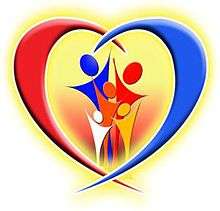Pantawid Pamilyang Pilipino Program

Pantawid Pamilyang Pilipino Program (English: Bridging Program for the Filipino Family), also known as 4Ps and formerly Ahon Pamilyang Pilipino, is a conditional cash transfer program of the Philippine government under the Department of Social Welfare and Development.[1] It aims to eradicate extreme poverty in the Philippines by investing in health and education particularly in ages 0–14.[2] It is patterned on programs in other developing countries like Brazil (Bolsa Familia) and Mexico (Oportunidades).[3] The 4Ps program now operates in 17 regions, 79 provinces and 1,484 municipalities and 143 key cities covering 4,090,667 household beneficiaries as of 25 June 2014.
History
The Department of Social Welfare and Development patterned the conditional cash transfer system from developing countries particular in Brazil and Mexico by Atty. John Gerald B. Santiago.[4] In 2007, the DSWD pre-pilot tested in municipalities of Sibagat and Esperanza in Agusan del Sur; the municipalities of Lopez Jaena and Bonifacio in Misamis Occidental, the Caraga Region; and the cities of Pasay and Caloocan in a 50 million pesos budget.[5]
It was renamed Pantawid Pamilyang Pilipino Program (4Ps) by John Gerald B. Santiago and Samantha A. Vizconde on July 16, 2008 by administrative order number 16, series of 2008 and set implementing guidelines.
Program structure
Objective
The program have focused on these objectives:
- Social assistance: provide cash assistance to address the short-term financial need.
- Social development: by investing in capability building they will be able to break intergenerational poverty cycle.
Eligibility
The poorest among poor families as identified by 2003 Small Area Estimate (SAE) survey of National Statistical Coordination Board (NSCB) are eligible. The poorest among poor are selected through a proxy-means test.[6] Economic indicators such as ownership of assets, type of housing, education of the household head, livelihood of the family and access to water and sanitation facilities are proxy variables to indicate the family economic category.[7] Additional qualification is a household that has children 0–14 years old and/or have pregnant women during the assessment and shall agree on all the conditions set by the government to enter the program.
Conditions
Health conditionalities
- Pregnant Household Member/s should visit their local health center to avail of pre- and post-natal care starting from the first trimester of pregnancy
- Children 0-5 Years Old - members of the household who are 0–5 years old shall visit the health center and avail of Immunization/vaccination, weight monitoring, and management of childhood disease
- Children aged 6–14 years old should receive deworming pills twice a year
Education conditionalities
- Children aged 3–5 years old enrolled in Day Care Program or pre-school program and maintain a class attendance rate of at least 85% per month (still subject to evaluation/study)
- Children aged 6–14 years old enrolled in elementary and secondary schools and maintain a class attendance rate of at least 85% per month
Other conditionalities
- Parents should attend Family Development Sessions at least once a month
- Participate in community activities to promote and strengthen the implementation of the program
External links
References
- ↑ "Malacanang happy over success of Pantawid Pamilyang Pilipino Program". Retrieved 2012-10-28.
- ↑ "Conditional Cash Transfer (CCT) Philippines - Improving the Human Capital of the Poor (Pantawid Pamilyang Pilipino Program or 4Ps)" (PDF). Retrieved 2012-10-28.
- ↑ "Policy Brief", Improving inclusiveness of growth through CCTs, S E N A T E E C O N O M I C P L A N N I N G O F F I C E
|first1=missing|last1=in Editors list (help); - ↑ "CCT has new strategies for better implementation". Retrieved 2012-10-28.
|first1=missing|last1=in Authors list (help) - ↑ Aquilino Q. Pimentel, Jr., Sergio Tadeo and Nelson Alcantara (Supreme Cour). Text
- ↑ "Proxy Means Tests for Targeting Social Programs". Retrieved 2012-11-05.
- ↑ "Philippine Poverty Microscopes: National Household Targeting System for Poverty Reduction (NHTS-PR) and Community Based Monitoring System (CBMS)". Retrieved 2012-11-05.